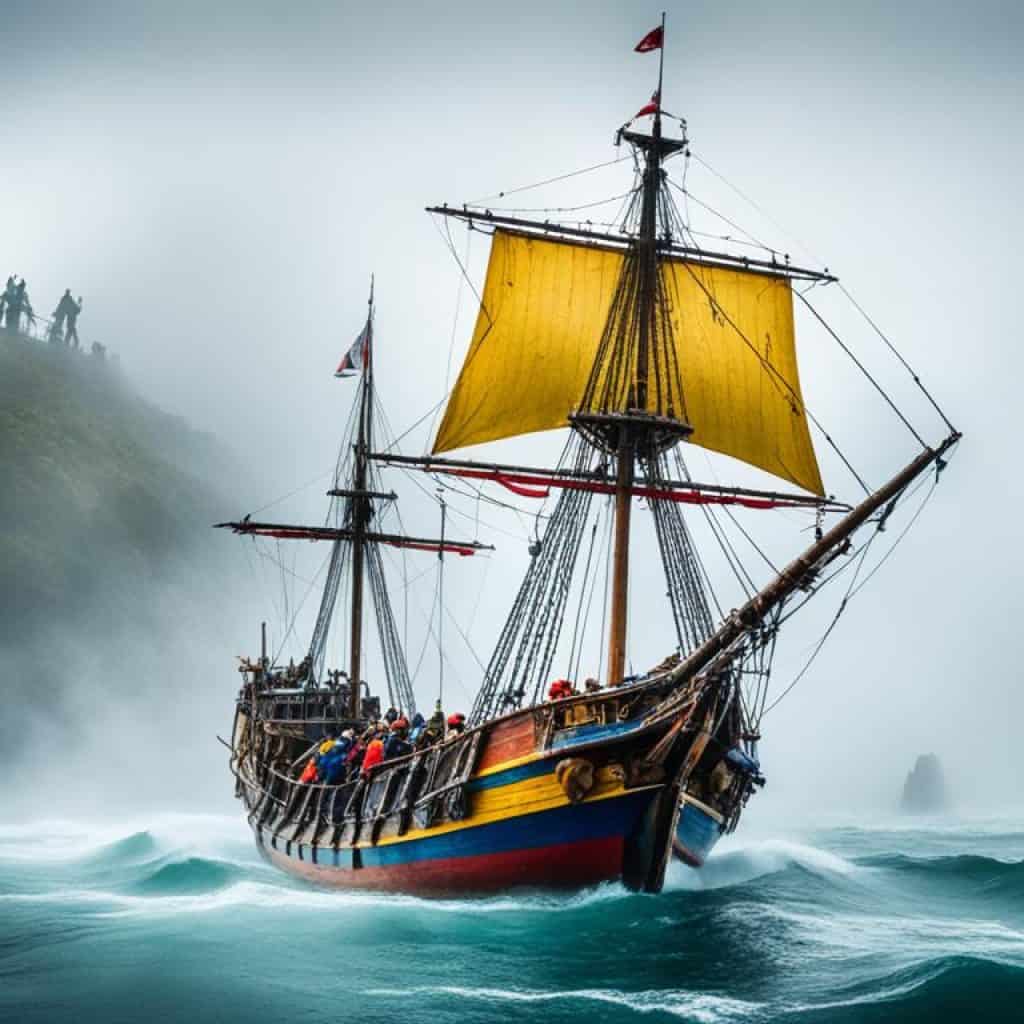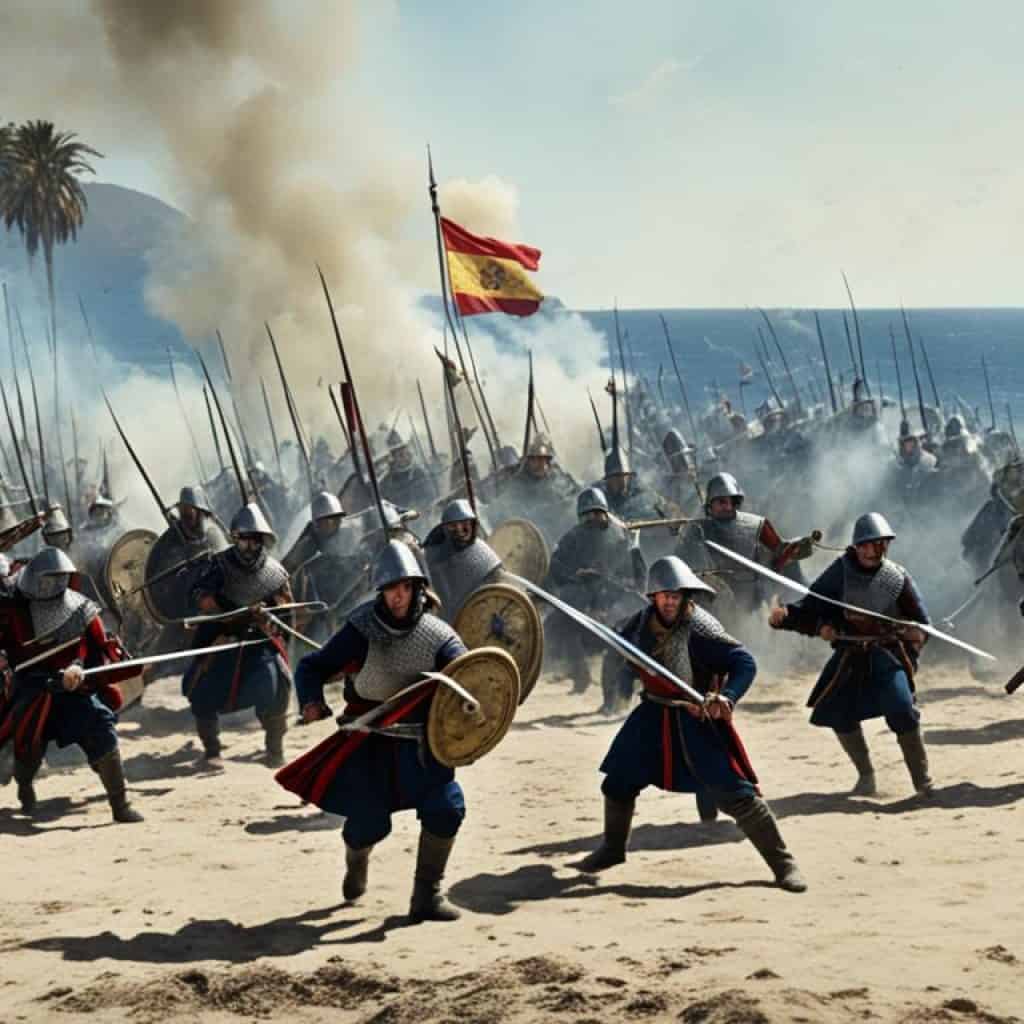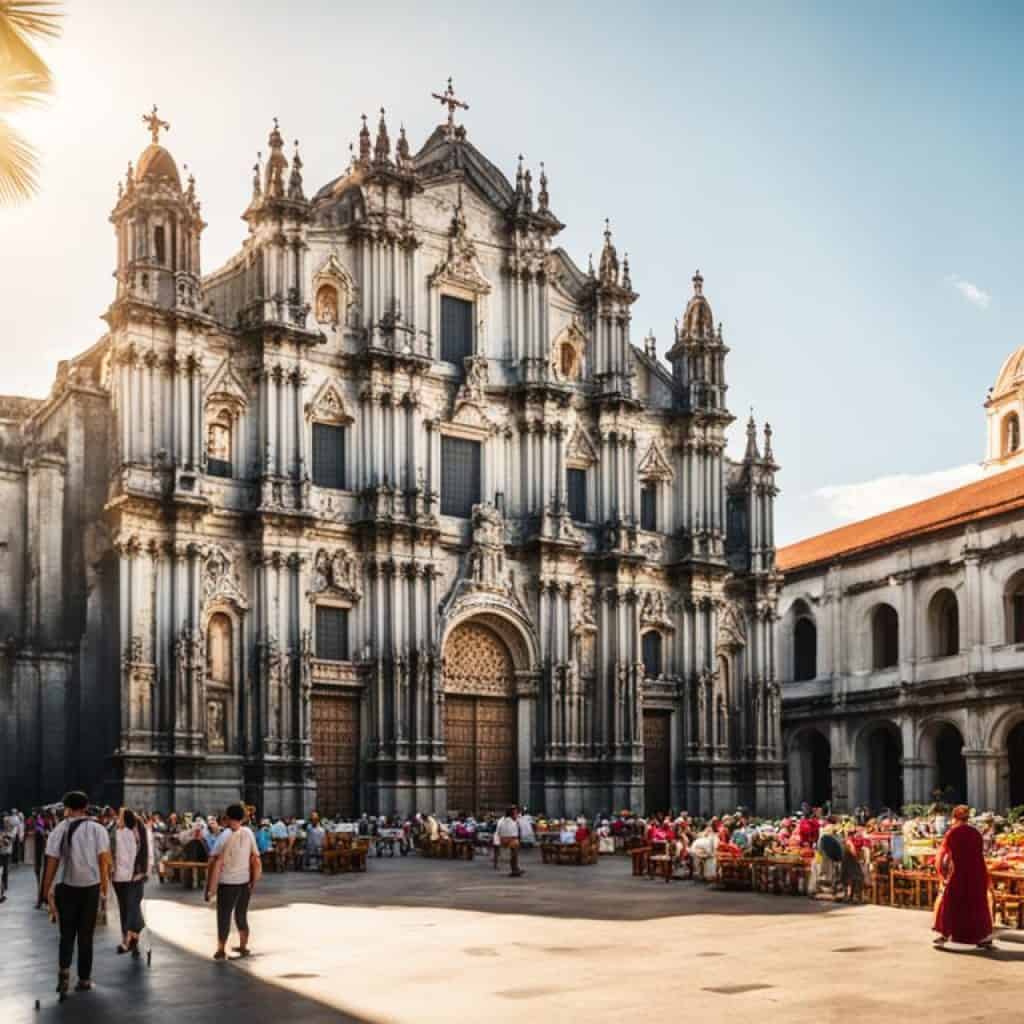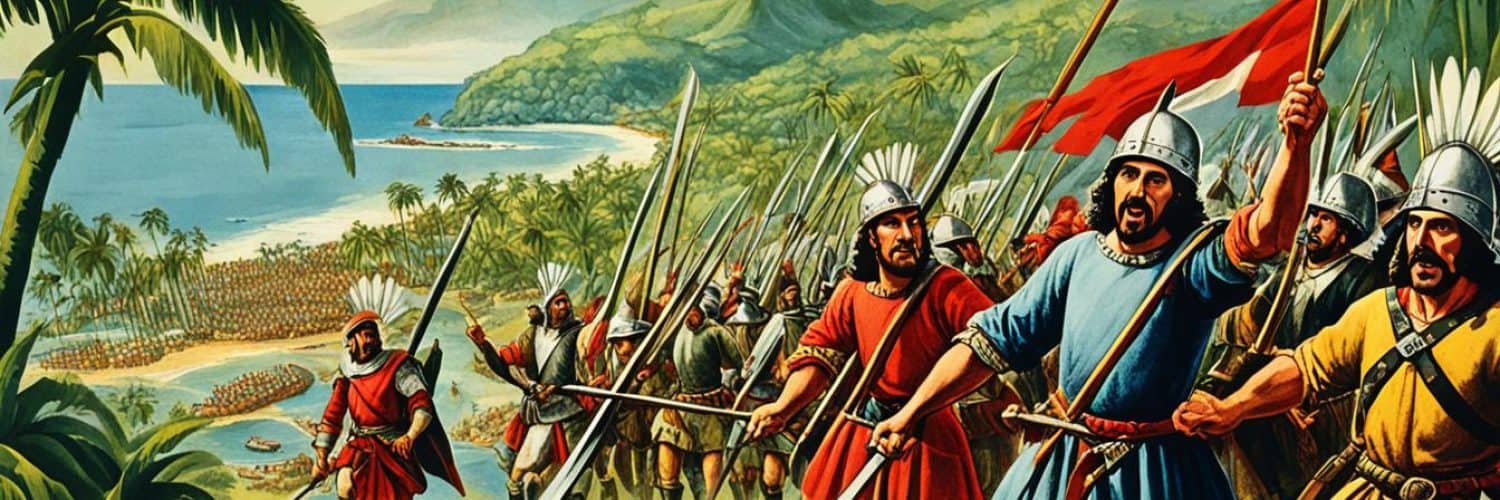Have you ever wondered about the impact of Spanish colonization in the Philippines? How did it shape the country’s history, culture, and society? Join us as we journey through the timeline of Spanish colonization in the Philippines and uncover its lasting influence.
Key Takeaways:
- The Spanish colonization of the Philippines occurred from 1565 to 1898.
- Before Spanish colonization, the Philippines had a vibrant precolonial period from 900 to 1565.
- The arrival of the Spanish in 1521 marked the beginning of the Spanish conquest.
- Spanish colonization led to significant changes in governance, religion, language, and social structures.
- The legacy of Spanish colonization continues to shape the Philippines today.
Precolonial period (900-1565)
In the history of the Philippines, the precolonial period refers to the time before the arrival of the Spanish colonizers in 1565. Spanning from 900 to 1565, this era was characterized by the presence of various indigenous communities and the formation of independent states or polities. During this period, the archipelago witnessed the rise of several historically documented states, each with its distinct culture and political structure.
Independent States and Polities
Throughout the precolonial period, the Philippines was home to notable states, such as Caboloan, Tondo, Maynila, Cebu, Butuan, and the Sultanates of Maguindanao, Buayan, Lanao, and Sulu. These states were organized under specific leaders or ruling families and had their own systems of governance. Within these states, trade, agriculture, and craftsmanship thrived, leading to prosperous economies and vibrant societies.
Diverse Cultures and Societies
The precolonial period of Philippine history showcases the rich cultural diversity of the islands. Each state had its unique customs, traditions, belief systems, and artistic expressions. Indigenous communities engaged in farming, fishing, weaving, metalworking, and other crafts. They developed their languages, social structures, and legal systems. The interaction between different states facilitated cultural exchange and trade networks, enhancing the overall development of the archipelago.
“The precolonial period of Philippine history was marked by the flourishing of indigenous communities and the formation of independent states, each with its own distinct culture and political organization.”
Maritime Connections
The geographical location of the Philippines allowed for extensive maritime connections with neighboring regions in Southeast Asia. Trade routes and seafaring expeditions played a vital role in facilitating cultural exchange, economic growth, and the spread of ideas. The Filipinos’ skills in shipbuilding and navigation made them active participants in the wider network of trade and diplomacy, contributing to the archipelago’s status as a regional hub.
Rise of Islam
During the precolonial period, Islam began to spread throughout the southern islands of the Philippines. Traders from the Islamic world introduced the religion, and Muslim communities emerged, particularly in Mindanao and Sulu. The Sultanates of Maguindanao, Buayan, Lanao, and Sulu embraced Islam as their religion and developed their distinctive political and social structures.
Indigenous Resistance
While some of these states engaged in peaceful trade and diplomatic relations with neighboring entities or with Chinese dynasties, there were also occasional conflicts and rivalries. Indigenous communities fiercely defended their territories against external threats or attempts at control. Resistance against foreign incursions and encroachments on their autonomy was not uncommon, highlighting the deep-rooted sense of identity and independence among precolonial Filipinos.
As we delve further into the history of the Philippines, we will explore the significant events and transformations that occurred during the Spanish colonial period from 1565 to 1898. Stay tuned for Section 3: Spanish colonial period (1565-1898).
Spanish colonial period (1565-1898)
The Spanish colonial period in the Philippines, lasting from 1565 to 1898, shaped the course of Philippine history and left a lasting impact on the country. During this time, the Spanish established permanent settlements and introduced their governance system, with Manila becoming the capital and center of Spanish activity.
“The Spanish colonial period in the Philippines is a significant era marked by the implementation of Spanish rule and the introduction of various social, cultural, and political changes.”
Under Spanish governance, the encomienda system was implemented, granting Spanish settlers land and labor from the indigenous Filipinos. This system resulted in the exploitation of the native population and the strengthening of Spanish control over different regions of the archipelago.
One of the most prominent influences of Spanish colonization was the conversion of Filipinos to Catholicism. Spanish missionaries set to work in spreading Christianity, building churches, and establishing the church as a central institution in colonial society.
“The Spanish governance in the Philippines brought about changes that had a lasting impact on the country’s society, culture, and religion.”
In addition to religion, Spanish culture and customs also left a deep imprint on the Philippines. The Spanish language became widespread, and Spanish practices merged with Filipino customs, resulting in a process of Filipinization under Spanish rule.
| Spanish Governance in the Philippines | Spanish Influence in the Philippines |
|---|---|
| Introduction of the encomienda system | Conversion of Filipinos to Catholicism |
| Establishment of permanent settlements | Merging of Spanish practices with Filipino customs |
| Centralization of power in Manila | Extension of the Spanish language |
However, Spanish rule in the Philippines was not without resistance. Filipinos fought for their independence and rebelled against Spanish colonialism, with notable revolts and uprisings throughout the centuries. Despite the challenges and difficulties, the Spanish colonial period profoundly shaped the Philippines and set the stage for future struggles for independence.
Spanish-American War and the End of Spanish Rule
The Spanish colonial period came to an end in 1898 with the defeat of Spain by the United States in the Spanish-American War. As a result of the war, Spain ceded the Philippines to the United States under the Treaty of Paris, ushering in a new era of colonization and administration.
The arrival of the Spanish
The Spanish arrived in the Philippines in 1521 during an expedition led by Ferdinand Magellan. However, their arrival was met with resistance in the Battle of Mactan, where Magellan lost his life.
It was not until 1565 that another Spanish expedition, led by Miguel López de Legazpi, successfully established a foothold in the Philippines and began the Spanish conquest. Legazpi first set up a settlement in Cebu, marking the first Spanish presence in the archipelago.
Despite initial successes, the Spanish faced resistance from Muslim Moro pirates and local leaders. The Battle of Mactan demonstrated the fierce opposition that the Spanish would encounter throughout their colonization efforts.

Spanish colonial governance
The Spanish administration in the Philippines during the colonial period was characterized by the establishment of Manila as the capital and center of governance. Initially directed from Mexico, the Spanish government later operated directly from Spain, asserting control over the archipelago.
The Spanish introduced the encomienda system, which granted land and labor from indigenous Filipinos to Spanish settlers. While ostensibly aimed at promoting economic development, this system resulted in the exploitation of the native population and the concentration of wealth in the hands of the Spanish elite.
Furthermore, the Spanish administration in the Philippines centered around the Catholic Church, which the Spanish monarchy considered as a crucial institution for maintaining control and spreading their influence. The church had wide-ranging powers and played a central role in colonial society.
Encomienda System
The encomienda system was implemented by the Spanish to reward conquistadors and settlers in the Philippines. Under this system, indigenous Filipinos were assigned to Spanish encomenderos who had the right to extract labor and tribute from them in exchange for protection and Christian conversion. However, this system often led to the abuse and exploitation of the native population.
Role of the Church
The Catholic Church was established as a central institution of Spanish colonial governance. Spanish friars played a significant role in spreading Christianity, establishing churches, and converting the indigenous people to Catholicism. The church also had the authority to administer justice, regulate marriages, and control education.
The Spanish administration in the Philippines, shaped by the encomienda system and the influential position of the Catholic Church, formed the basis of Spanish colonial governance. These structures had a lasting impact on the social, economic, and cultural landscape of the Philippines.
| Key Features | Impact |
|---|---|
| Encomienda System | Exploitation of indigenous population, concentration of wealth in the hands of Spanish settlers |
| Role of the Church | Spread of Christianity, influence over various aspects of colonial society |
The image above visually represents the Spanish administration in the Philippines, with a focus on the encomienda system and the role of the Catholic Church. It serves as a visual reminder of the historical context and the central elements of Spanish colonial governance.
Spanish influence and culture
The Spanish colonization of the Philippines had a profound impact on the culture and society of the archipelago. The Spanish brought Christianity to the islands, building churches and converting Filipinos to Catholicism. As a result, Catholicism became deeply ingrained in Filipino culture, shaping religious festivals and traditions that remain integral to Filipino identity today.
The Spanish language also had a significant influence, becoming widespread during the colonial period. The incorporation of Spanish words and phrases into Filipino languages created a unique linguistic fusion that still persists. Filipino customs and traditions were also influenced by Spanish culture, with elements such as fiestas, traditional music, and dances reflecting the blending of Spanish and indigenous traditions.
“The Spanish colonization left an indelible mark on Filipino culture, introducing new religious practices, language, and customs that have become deeply woven into the fabric of Filipino society.”
However, it is important to note that as Filipino culture embraced Spanish influences, there was also a process of Filipinization under Spanish rule. Filipinos adapted and transformed Spanish customs to fit their own cultural context, creating a distinct Filipino-Spanish hybrid culture. This process of cultural assimilation allowed Filipinos to negotiate their identity and preserve elements of their own traditions while embracing new influences.
| Spanish Influence in the Philippines | Spanish Cultural Impact | Filipinization under Spanish Rule |
|---|---|---|
| Introduction of Christianity | Spread of the Spanish language | Adaptation of Spanish customs to Filipino context |
| Construction of churches | Incorporation of Spanish words into Filipino languages | Preservation of indigenous traditions alongside Spanish influences |
| Conversion of Filipinos to Catholicism | Influence on Filipino customs and traditions | Creation of a distinct Filipino-Spanish hybrid culture |
The Spanish influence on Filipino culture continues to resonate today, shaping various aspects of Filipino life. From religious practices to language and cuisine, the legacy of Spanish colonization is deeply ingrained in the collective consciousness of the Filipino people.
Spanish-Moro conflicts
The Spanish colonization of the Philippines was not without challenges and conflicts, particularly with the Muslim Moro pirates and leaders in Mindanao and Sulu. These conflicts, known as the Spanish-Moro conflicts, posed a significant threat to Spanish rule in the archipelago.
Spanish battles against Moro pirates were characterized by raids and counter-raids, as well as territorial disputes. The Moros, skilled seafarers and warriors, often proved difficult to defeat. The Spanish waged intermittent military campaigns against the Moros, but conclusive results were elusive until the mid-19th century.
The ongoing Moro rebellion and resistance further complicated the establishment of Spanish rule. It took several centuries for the Spanish to gain a firmer foothold in Mindanao and Sulu. These conflicts not only challenged Spanish authority but also hindered their efforts to fully subjugate and govern the entire archipelago.
Spanish Battles Against Moro Pirates
The Spanish faced formidable challenges in their battles against Moro pirates. The Moros were skilled seafarers and relied on their knowledge of the treacherous waters of Mindanao and Sulu to engage in piracy and raiding activities. Spanish attempts to suppress the Moro pirates and secure the seas were met with fierce resistance and cunning strategies.
“The Moro pirates were a constant menace to Spanish shipping and coastal communities. They launched swift raids, plundering villages and capturing captives for slave trade. Spanish efforts to counter the Moro threat often led to prolonged and bloody battles.”
The Spanish sought to weaken the Moro power by launching military expeditions and constructing fortifications along the coasts. However, the Moros’ knowledge of the local terrain and their effective use of guerrilla tactics made it challenging for the Spanish to gain a decisive advantage.
Spanish Rule in Mindanao and Sulu
Spanish rule in Mindanao and Sulu was tenuous and fragmented due to the resistance of the Moro leaders and their communities. The Moros fiercely defended their autonomy and resisted Spanish attempts to establish control.
The Spanish faced territorial disputes and frequent clashes with Moro leaders such as Sultan Kudarat of Maguindanao and Sultan Jamalul Kiram II of Sulu. The Moros were able to maintain their independence and control over their territories despite Spanish efforts to subjugate them.
The Spanish-Moro conflicts contributed to the difficulty of fully establishing Spanish rule throughout the archipelago. It was only in the late 19th century, with the introduction of more effective tactics and increased military presence, that the Spanish were able to exert more control over Mindanao and Sulu.

The Spanish-Moro conflicts left a lasting impact on the history and culture of the Philippines. These conflicts shaped the dynamics of power and resistance in Mindanao and Sulu, and their legacy continues to influence the region today.
Impact on indigenous communities
The Spanish colonization of the Philippines had a profound impact on the indigenous communities of the archipelago. The arrival of the Spanish brought significant changes to the social structures, labor systems, and health of the native population.
Under Spanish rule, many Filipinos were subjected to forced labor, known as the encomienda system. Indigenous people were forced to work in Spanish-controlled industries, such as agriculture, mining, and construction, often facing harsh working conditions and exploitation.
The introduction of Spanish governance also disrupted the traditional hierarchies and leadership systems of indigenous communities. The Spanish established their own administrative structures and appointed local elites as intermediaries, further consolidating their control over the native population.
However, indigenous resistance to Spanish colonization was widespread throughout the centuries of Spanish rule. Native communities fought back through various uprisings, revolts, and guerrilla warfare, defending their lands, cultures, and autonomy. Notable resistance movements include the Igorot Revolt in the 1600s and the Dagohoy Rebellion in the 1700s.
Indigenous communities also faced the devastating impact of diseases introduced by the Spanish, such as smallpox, measles, and influenza. These diseases, to which the native population had little immunity, caused widespread deaths and decimated entire communities.
“The Spanish colonization not only brought about forced labor and social upheaval but also sparked indigenous resistance, as native communities fought to preserve their autonomy and way of life.” – Dr. Maria Santos, Philippine historian
The lasting impact of Spanish colonization on indigenous communities in the Philippines is evident in the social, cultural, and economic disparities that persist today. Efforts to recognize and reclaim indigenous rights and heritage continue, as the Philippines strives to acknowledge and rectify the historical injustices inflicted upon its native population.
| Impact of Spanish Colonization on Indigenous Communities | Description |
|---|---|
| Forced Labor | Indigenous communities subjected to labor exploitation in Spanish-controlled industries, facing harsh working conditions and economic disparities. |
| Social Disruption | Spanish governance disrupted traditional social structures, hierarchies, and leadership systems in indigenous communities. |
| Resistance Movements | Indigenous communities fought back through uprisings, revolts, and guerrilla warfare, defending their lands, cultures, and autonomy. |
| Disease and Mortality | Introduction of diseases by the Spanish, such as smallpox and measles, caused high mortality rates in indigenous communities. |
| Legacy and Disparities | The impact of Spanish colonization continues to shape social, cultural, and economic disparities among indigenous communities in the Philippines. |
Economic impact
The Spanish colonization of the Philippines had a profound economic impact on the region. The Spanish established trade networks that shaped the country’s economy and exerted control over trade, significantly influencing its development.
Trade During Spanish Colonization
Under Spanish rule, trade in the Philippines experienced significant changes and expansions. One of the most prominent trade routes was the Manila Galleon trade, which linked the Philippines with China and other Asian countries.
The Manila Galleon trade involved the exchange of goods between Mexico and the Philippines. Silver and other goods from Mexico were brought to the Philippines, while Chinese goods were traded and brought back to Mexico. This trade route played a vital role in connecting the Spanish Empire with Asia and contributed to the flow of wealth and commodities across continents.
Spanish Control of Trade
The Spanish exercised strict control over trade in the Philippines, aiming to maximize their profits and maintain their dominance in the region. They imposed restrictions on indigenous and Chinese merchants, privileging Spanish and other European traders.
This control enabled the Spanish to maintain monopolies over certain goods and exert influence over the local economy. The Spanish also introduced new crops and agricultural techniques, such as tobacco and indigo farming, further influencing the economic landscape of the Philippines.
| Effects of Spanish Control of Trade | Economic Impact |
|---|---|
| Monopoly on trade | Restricted access for indigenous and Chinese merchants |
| Introduction of new crops | Expansion of agricultural production |
| Increased interaction with other Asian nations | Exchange of goods and cultural influences |
| Concentration of wealth in Spanish hands | Socioeconomic disparities |
The Spanish control of trade, combined with their governance and religious policies, shaped the economic landscape of the Philippines and influenced the cultural exchange between different nations.
“The Spanish colonization introduced new trade routes and economic opportunities, but it also resulted in the concentration of economic power in the hands of the Spanish. The indigenous and Chinese merchants faced limitations and discrimination, leading to socioeconomic disparities.” – Historian Juan de la Cruz
The economic impact of Spanish colonization in the Philippines has had long-lasting effects that continue to shape the country’s economy today.
Cultural and religious legacy
The Spanish colonization of the Philippines left a profound and enduring impact on the country’s culture and religion. Spanish architecture, characterized by magnificent churches and colonial-era buildings, continues to adorn many parts of the Philippines, serving as a visual reminder of the country’s colonial past. These architectural treasures stand as a testament to the rich cultural heritage and architectural prowess of the Spanish colonizers.
Catholicism, introduced by the Spanish, took root in the Philippines and became deeply ingrained in Filipino culture. The influence of Catholicism is evident in the multitude of religious festivals, traditions, and practices that form an integral part of Filipino identity. From grand processions during Holy Week to vibrant fiestas honoring patron saints, religious celebrations permeate everyday Filipino life.

Spanish surnames and language have also left an indelible mark on the Filipino population. Many Filipinos still bear Spanish surnames, a remnant of the Spanish colonial era. The Spanish language, although no longer widely spoken, has influenced the Filipino language, with Spanish loanwords integrated into everyday vocabulary. This linguistic fusion reflects the historical and cultural connections between Spain and the Philippines.
Cultural Heritage Preserved:
- Spanish architecture, including churches and colonial-era buildings, can still be admired in many parts of the Philippines.
- Catholicism has become deeply rooted in Filipino culture, shaping religious festivals and traditions.
A Linguistic Connection:
- Spanish surnames and loanwords have left an enduring linguistic impact on the Filipino population.
Spanish-American War and the end of Spanish rule
The Spanish-American War, fought in 1898, brought an end to Spanish rule in the Philippines.
During the conflict, the United States emerged victorious, leading to significant changes in the Philippine archipelago. As a result of the Treaty of Paris, signed in the same year, Spain ceded the Philippines to the United States.
Under American control, a new era of colonization and administration began in the Philippines. The United States took over the governance of the islands, establishing a colonial rule that would shape the course of Philippine history.
This image illustrates the United States’ influence and control over the Philippines following the Spanish-American War.
Filipino resistance and independence movements
During the Spanish colonial period, Filipinos displayed unwavering resilience and determination in their quest for independence. The Philippine Revolution emerged as a pivotal movement that sought to liberate the Philippines from Spanish rule, led by prominent figures such as Andrés Bonifacio and Emilio Aguinaldo.
The secret society known as the Katipunan played a crucial role in organizing and mobilizing Filipino resistance against Spanish oppression. Founded by Bonifacio, the Katipunan served as a platform for like-minded individuals to unify and fight for the nation’s freedom. Through their underground activities, the Katipunan ignited a spark of nationalist sentiment that ignited the flames of revolution.
“The love of country is never in vain. But if needed, it is always worthy to die for the sake of freedom.” – Andrés Bonifacio
The Philippine Revolution marked a turning point in Filipino history, as it laid the groundwork for future struggles for independence. The courage and determination displayed by Filipino revolutionaries inspired generations to come and became an enduring symbol of the Filipino spirit.
Legacy and ongoing impact
The legacy of Spanish colonization in the Philippines continues to shape the country’s history, culture, and society today. The lasting influence of Spanish rule can be seen in various aspects of Filipino life.
Language:
The Spanish influence on language is evident in the presence of Spanish loanwords in the Filipino vocabulary. Words such as “kampeon” (champion), “mesa” (table), and “kutsara” (spoon) bear witness to the linguistic impact of Spanish colonization.
Religion:
The arrival of the Spanish brought Catholicism to the Philippines, which remains the dominant religion in the country. The influence of Catholicism can be seen in the numerous churches and religious festivals that are deeply ingrained in Filipino culture.
Culture:
The fusion of Spanish and Filipino cultures during the colonial period gave rise to a unique blend of traditions, customs, and artistic expressions. This cultural syncretism is evident in various aspects of Filipino life, from cuisine to music and dance.
Economic Disparities and Social Inequalities:
The effects of Spanish colonization, such as wealth disparities and social hierarchies, continue to shape the Philippine society. The Spanish implemented systems that favored the Spanish elite, resulting in economic inequalities that persist to this day.
Philippines’ Relationship with the United States:
The Spanish-American War, which led to the end of Spanish rule in the Philippines, marked the beginning of American colonization. The legacy of Spanish colonization played a crucial role in shaping the Philippines’ relationship with the United States and the subsequent history of the country.
The legacy of Spanish colonization in the Philippines is complex and multifaceted. While it brought elements of progress and development, it also left behind lasting impacts that continue to shape the Philippines today. Understanding this legacy is essential in comprehending the rich and diverse history of the country.
Conclusion
The Spanish colonization of the Philippines left an indelible mark on the country’s history and culture. Spanning over three centuries, from the Spanish arrival in the 16th century to the end of Spanish rule in 1898, this period brought about significant changes to the governance, religion, language, and social structures of the Philippines.
Under Spanish rule, the Philippines became the Captaincy General of the Philippines within the Spanish East Indies. Manila emerged as the capital and center of Spanish activity, while Spanish influence and control spread throughout the archipelago. The Spanish introduced their governance system, implemented the encomienda system, and converted Filipinos to Catholicism.
Today, the legacy of Spanish colonization continues to shape the Philippines. The Spanish influence on language, religion, and culture remains deeply rooted in Filipino society. Spanish surnames, colonial-era buildings, and Catholic traditions are prevalent, showcasing the lasting impact of this period.
The Spanish colonization of the Philippines marks a crucial chapter in the country’s history, setting the stage for further struggles for independence and shaping its relationship with the United States. Understanding this legacy is crucial to comprehending the complexities of the Philippine identity and the ongoing impacts of colonialism.


















Add comment